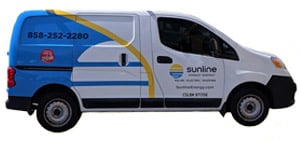We recently came across a really interesting article written by Dan McSwain in U-T San Diego.
The title was, Is Going Solar an Investment?
McSwain is a strong supporter of solar. But in the piece, he recounts his own experiences shopping around for San Diego solar installers. The focus of his research was on the “returns” that renewable energy offers.
More specifically, he wanted to study whether the internal rate of return (IRR) of a solar installation was equal or superior to other investment opportunities – namely the stock market.
Ultimately, his conclusion was that there are better vehicles out there.
At Sunline Energy, we couldn’t disagree more.
Let’s explore.
Some Background on McSwain’s Solar San Diego Study
It’s worth pointing out that McSwain’s analysis is strictly a financial one. He acknowledges the environmental benefits of solar as a side note. He also points out that solar helps with energy independence and security.
It’s also important to mention that his monthly electricity bill is only $55 a month (something you only discover on page 2 of the article).
But why do we disagree with his overall assessment?
1. His Numbers Seem a Bit Off
For starters, he mentions that his new solar PV system will cost $13,000+ and deliver a payback period of 10 years.
For someone with such a small electricity bill, buying a $13,000 solar installation seems like overkill. And if you’re using very limited electricity bill savings to fuel your payback period, no wonder it will take 10+ years to fully cover the cost.
Keep in mind that:
- average solar installation costs for a standard 5kW residential system is about $10K in California (after incentives)
- average payback periods for solar installations of this size are between 4 to 6 years
Moreover, the author assumes that his solar installation will die after 20 years:
- 25 years is what most solar manufacturers offer (he actually does point this out)
- and with some simple tips, it’s possible to get 40+ years out of your solar installation
2. Solar Is a Safe Investment
After running through his calculations, McSwain determines that the IRR of his solar installation would be about 7.95% – which is less than the 10% he believes he can get from the stock market.
It’s true that the stock market has performed remarkably well throughout much of its long history. And he rightfully points out that there are many 20-year stretches in which returns match or exceed 10%.
But anyone who lost money in 2008 and 2009 understands that the stock market also has really bad stretches.
Solar, on the other hand, performs consistently well.
Even if incentives expire, most solar programs will grandfather in current members. So if net metering disappears in 2017, for example, those who joined before the cut-off date will continue to participate in the program.
Whereas Wall Street is full of risk and erratic behavior, the Sun remains constant. Moreover, most solar incentives are fairly stable, allowing one to accurately map out payback periods, returns, and costs – both today and in the future.
Stay Tuned for Part 2 of Our Solar San Diego Rebuttal
In the next post, we’ll continue our discussion of Mr. McSwain’s recent article. In the meantime, don’t hesitate to contact us directly if you have any questions about solar energy.
All consultations are 100% free.

